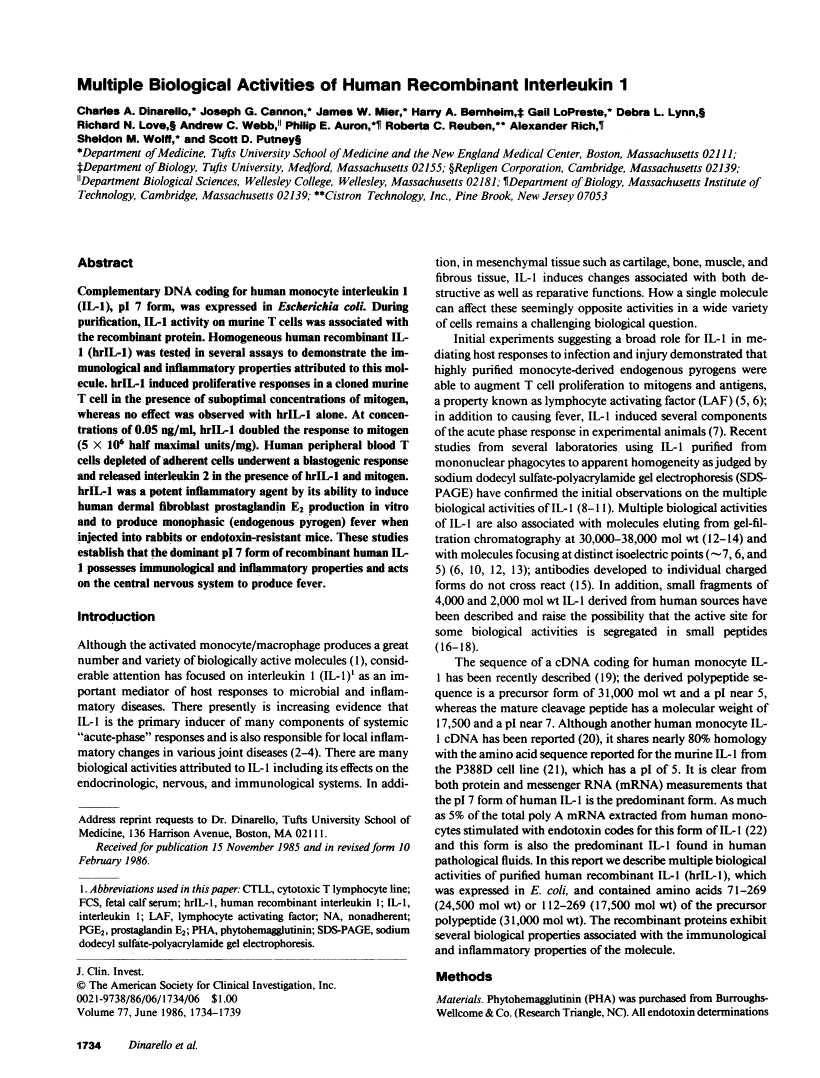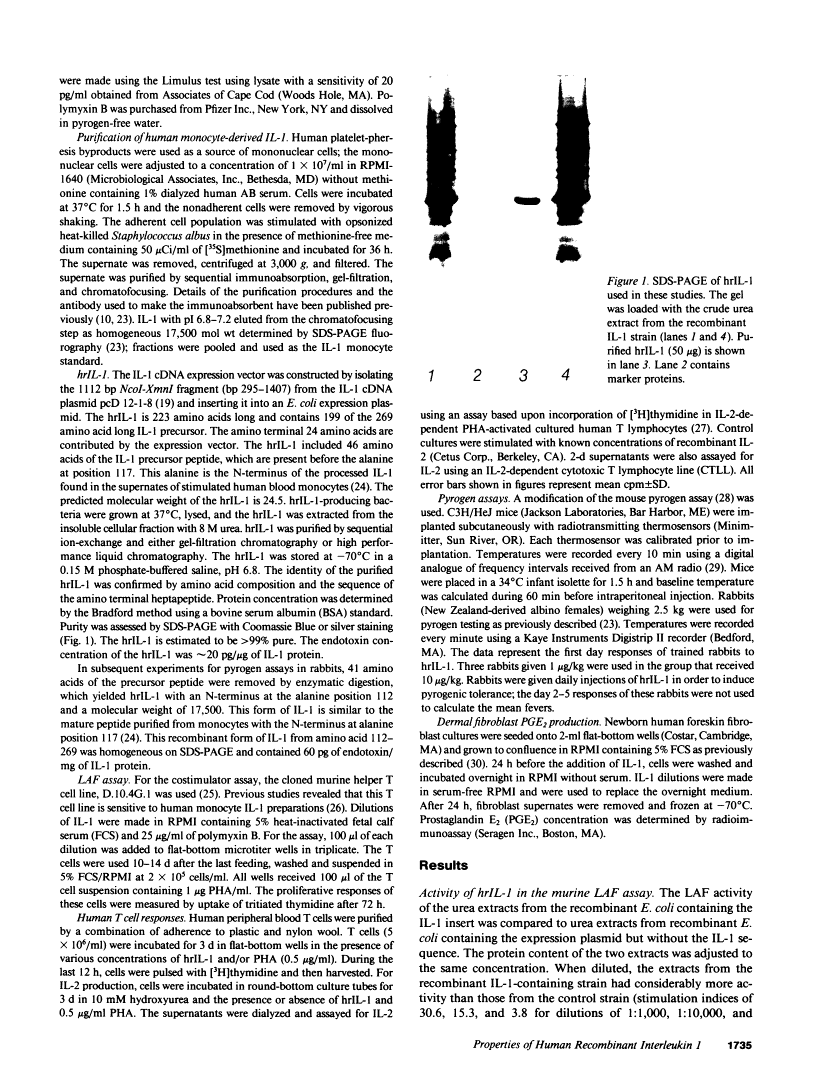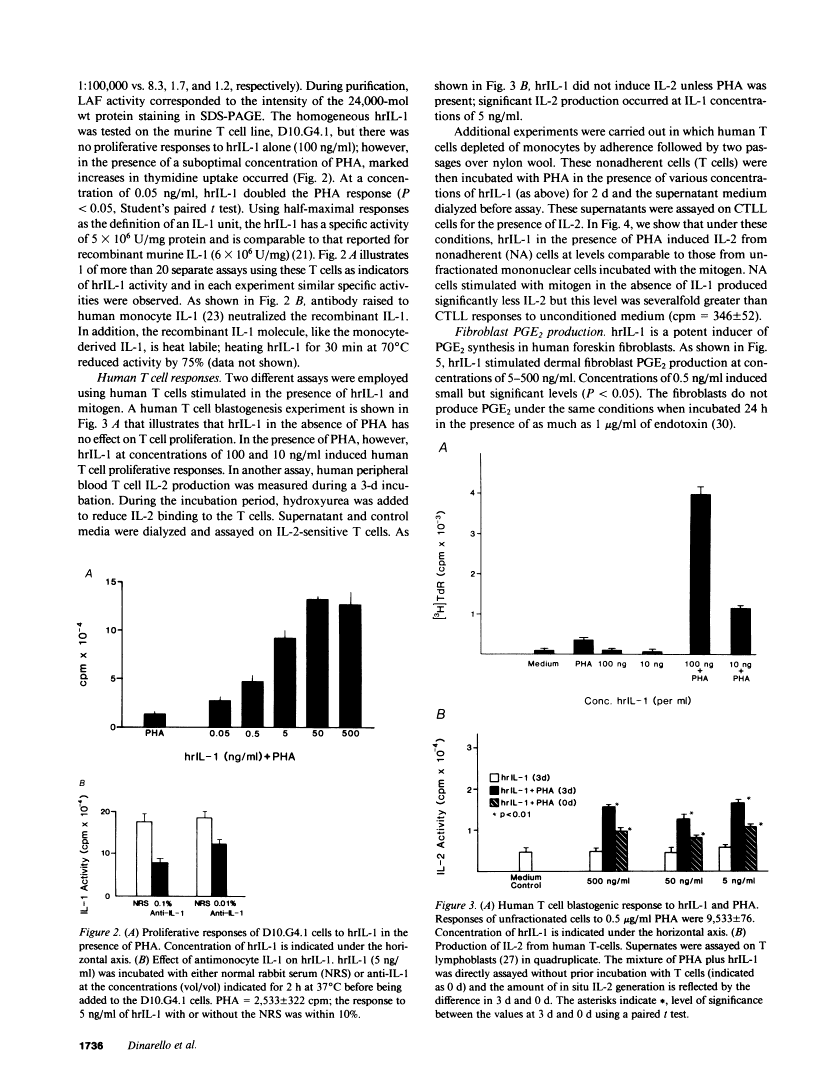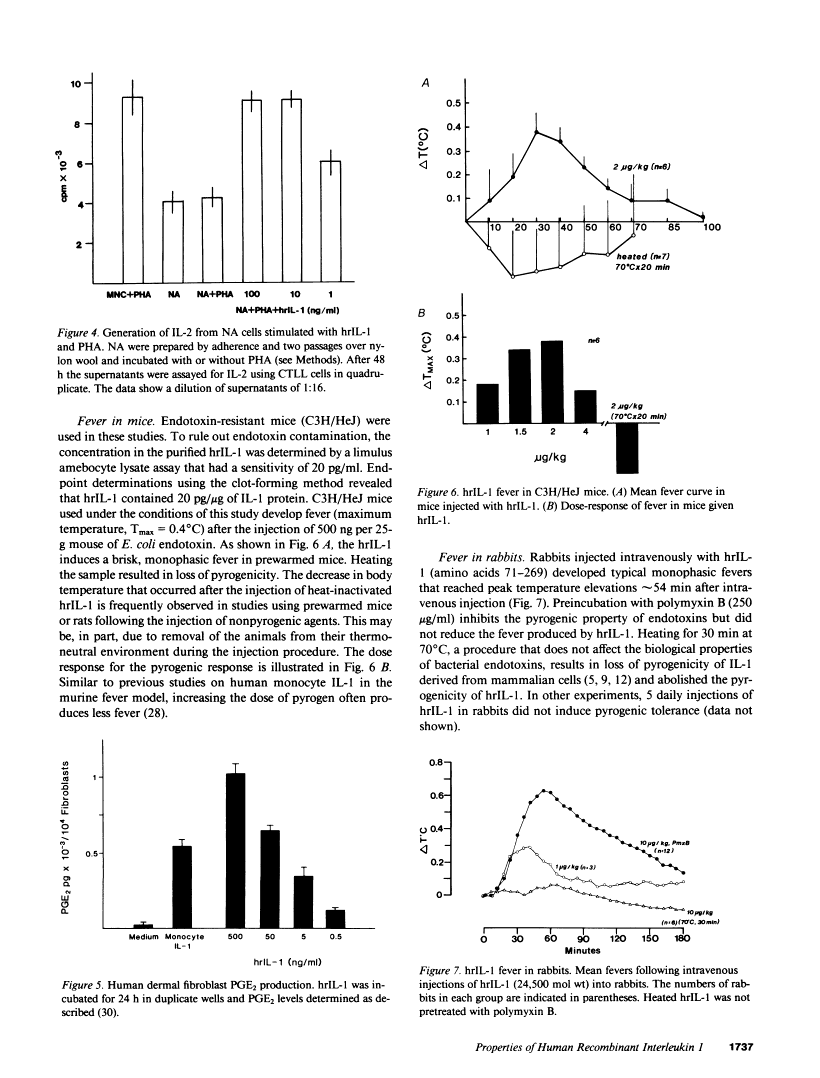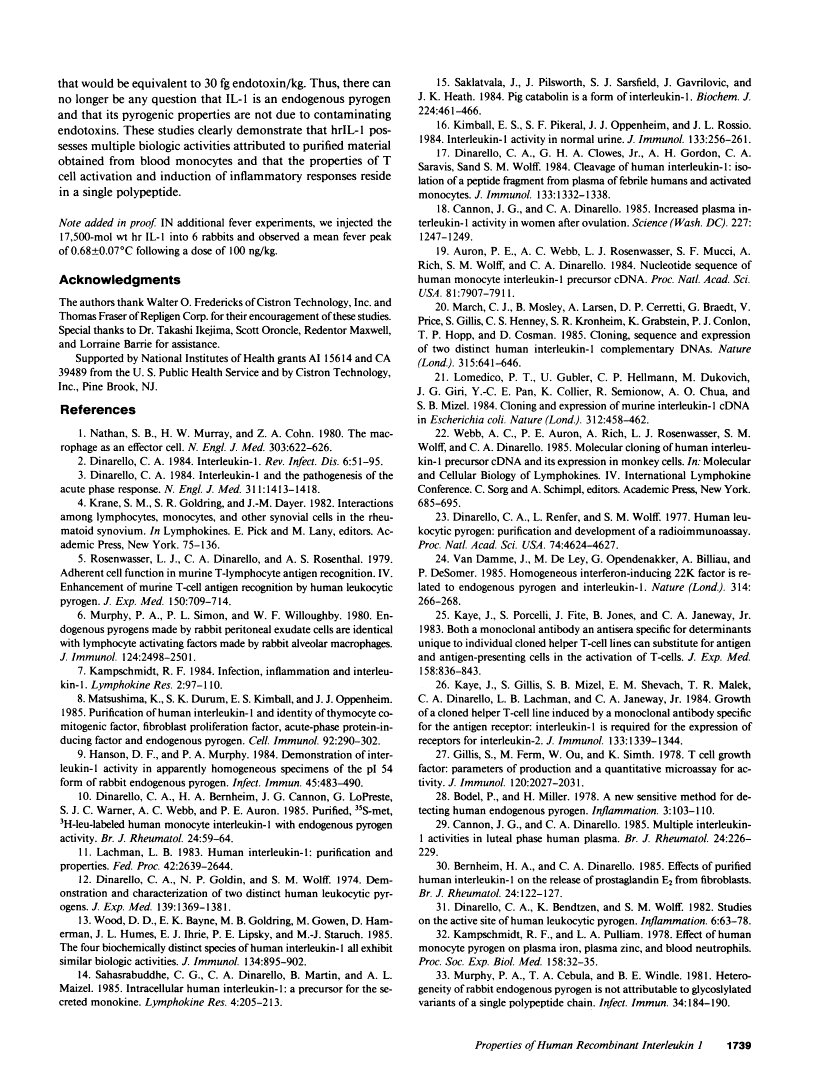Abstract
Free full text

Multiple biological activities of human recombinant interleukin 1.
Abstract
Complementary DNA coding for human monocyte interleukin 1 (IL-1), pI 7 form, was expressed in Escherichia coli. During purification, IL-1 activity on murine T cells was associated with the recombinant protein. Homogeneous human recombinant IL-1 (hrIL-1) was tested in several assays to demonstrate the immunological and inflammatory properties attributed to this molecule. hrIL-1 induced proliferative responses in a cloned murine T cell in the presence of suboptimal concentrations of mitogen, whereas no effect was observed with hrIL-1 alone. At concentrations of 0.05 ng/ml, hrIL-1 doubled the response to mitogen (5 X 10(6) half maximal units/mg). Human peripheral blood T cells depleted of adherent cells underwent a blastogenic response and released interleukin 2 in the presence of hrIL-1 and mitogen. hrIL-1 was a potent inflammatory agent by its ability to induce human dermal fibroblast prostaglandin E2 production in vitro and to produce monophasic (endogenous pyrogen) fever when injected into rabbits or endotoxin-resistant mice. These studies establish that the dominant pI 7 form of recombinant human IL-1 possesses immunological and inflammatory properties and acts on the central nervous system to produce fever.
Full text
Full text is available as a scanned copy of the original print version. Get a printable copy (PDF file) of the complete article (1.2M), or click on a page image below to browse page by page. Links to PubMed are also available for Selected References.
Images in this article
Click on the image to see a larger version.
Selected References
These references are in PubMed. This may not be the complete list of references from this article.
- Nathan CF, Murray HW, Cohn ZA. The macrophage as an effector cell. N Engl J Med. 1980 Sep 11;303(11):622–626. [Abstract] [Google Scholar]
- Dinarello CA. Interleukin-1. Rev Infect Dis. 1984 Jan-Feb;6(1):51–95. [Abstract] [Google Scholar]
- Dinarello CA. Interleukin-1 and the pathogenesis of the acute-phase response. N Engl J Med. 1984 Nov 29;311(22):1413–1418. [Abstract] [Google Scholar]
- Rosenwasser LJ, Dinarello CA, Rosenthal AS. Adherent cell function in murine T-lymphocyte antigen recognition. IV. Enhancement of murine T-cell antigen recognition by human leukocytic pyrogen. J Exp Med. 1979 Sep 19;150(3):709–714. [Europe PMC free article] [Abstract] [Google Scholar]
- Murphy PA, Simon PL, Willoughby WF. Endogenous pyrogens made by rabbit peritoneal exudate cells are identical with lymphocyte-activating factors made by rabbit alveolar macrophages. J Immunol. 1980 May;124(5):2498–2501. [Abstract] [Google Scholar]
- Kampschmidt RF. Infection, inflammation, and interleukin 1 (IL-1). Lymphokine Res. 1983;2(3):97–102. [Abstract] [Google Scholar]
- Matsushima K, Durum SK, Kimball ES, Oppenheim JJ. Purification of human interleukin 1 from human monocyte culture supernatants and identity of thymocyte comitogenic factor, fibroblast-proliferation factor, acute-phase protein-inducing factor, and endogenous pyrogen. Cell Immunol. 1985 May;92(2):290–301. [Abstract] [Google Scholar]
- Hanson DF, Murphy PA. Demonstration of interleukin 1 activity in apparently homogeneous specimens of the pI 5 form of rabbit endogenous pyrogen. Infect Immun. 1984 Aug;45(2):483–490. [Europe PMC free article] [Abstract] [Google Scholar]
- Lachman LB. Human interleukin 1: purification and properties. Fed Proc. 1983 Jun;42(9):2639–2645. [Abstract] [Google Scholar]
- Dinarello CA, Goldin NP, Wolff SM. Demonstration and characterization of two distinct human leukocytic pyrogens. J Exp Med. 1974 Jun 1;139(6):1369–1381. [Europe PMC free article] [Abstract] [Google Scholar]
- Wood DD, Bayne EK, Goldring MB, Gowen M, Hamerman D, Humes JL, Ihrie EJ, Lipsky PE, Staruch MJ. The four biochemically distinct species of human interleukin 1 all exhibit similar biologic activities. J Immunol. 1985 Feb;134(2):895–903. [Abstract] [Google Scholar]
- Sahasrabuddhe CG, Dinarello C, Martin B, Maizel AL. Intracellular human IL-1: a precursor for the secreted monokine. Lymphokine Res. 1985 Summer;4(3):205–213. [Abstract] [Google Scholar]
- Saklatvala J, Pilsworth LM, Sarsfield SJ, Gavrilovic J, Heath JK. Pig catabolin is a form of interleukin 1. Cartilage and bone resorb, fibroblasts make prostaglandin and collagenase, and thymocyte proliferation is augmented in response to one protein. Biochem J. 1984 Dec 1;224(2):461–466. [Europe PMC free article] [Abstract] [Google Scholar]
- Kimball ES, Pickeral SF, Oppenheim JJ, Rossio JL. Interleukin 1 activity in normal human urine. J Immunol. 1984 Jul;133(1):256–260. [Abstract] [Google Scholar]
- Dinarello CA, Clowes GH, Jr, Gordon AH, Saravis CA, Wolff SM. Cleavage of human interleukin 1: isolation of a peptide fragment from plasma of febrile humans and activated monocytes. J Immunol. 1984 Sep;133(3):1332–1338. [Abstract] [Google Scholar]
- Cannon JG, Dinarello CA. Increased plasma interleukin-1 activity in women after ovulation. Science. 1985 Mar 8;227(4691):1247–1249. [Abstract] [Google Scholar]
- Auron PE, Webb AC, Rosenwasser LJ, Mucci SF, Rich A, Wolff SM, Dinarello CA. Nucleotide sequence of human monocyte interleukin 1 precursor cDNA. Proc Natl Acad Sci U S A. 1984 Dec;81(24):7907–7911. [Europe PMC free article] [Abstract] [Google Scholar]
- March CJ, Mosley B, Larsen A, Cerretti DP, Braedt G, Price V, Gillis S, Henney CS, Kronheim SR, Grabstein K, et al. Cloning, sequence and expression of two distinct human interleukin-1 complementary DNAs. Nature. 1985 Jun 20;315(6021):641–647. [Abstract] [Google Scholar]
- Lomedico PT, Gubler U, Hellmann CP, Dukovich M, Giri JG, Pan YC, Collier K, Semionow R, Chua AO, Mizel SB. Cloning and expression of murine interleukin-1 cDNA in Escherichia coli. Nature. 312(5993):458–462. [Abstract] [Google Scholar]
- Dinarello CA, Renfer L, Wolff SM. Human leukocytic pyrogen: purification and development of a radioimmunoassay. Proc Natl Acad Sci U S A. 1977 Oct;74(10):4624–4627. [Europe PMC free article] [Abstract] [Google Scholar]
- Van Damme J, De Ley M, Opdenakker G, Billiau A, De Somer P, Van Beeumen J. Homogeneous interferon-inducing 22K factor is related to endogenous pyrogen and interleukin-1. Nature. 1985 Mar 21;314(6008):266–268. [Abstract] [Google Scholar]
- Kaye J, Porcelli S, Tite J, Jones B, Janeway CA., Jr Both a monoclonal antibody and antisera specific for determinants unique to individual cloned helper T cell lines can substitute for antigen and antigen-presenting cells in the activation of T cells. J Exp Med. 1983 Sep 1;158(3):836–856. [Europe PMC free article] [Abstract] [Google Scholar]
- Kaye J, Gillis S, Mizel SB, Shevach EM, Malek TR, Dinarello CA, Lachman LB, Janeway CA., Jr Growth of a cloned helper T cell line induced by a monoclonal antibody specific for the antigen receptor: interleukin 1 is required for the expression of receptors for interleukin 2. J Immunol. 1984 Sep;133(3):1339–1345. [Abstract] [Google Scholar]
- Gillis S, Ferm MM, Ou W, Smith KA. T cell growth factor: parameters of production and a quantitative microassay for activity. J Immunol. 1978 Jun;120(6):2027–2032. [Abstract] [Google Scholar]
- Bodel P, Miller H. A new sensitive method for detecting human endogenous (leukocyte) pyrogen. Inflammation. 1978 Mar;3(1):103–110. [Abstract] [Google Scholar]
- Situnayake RD, McConkey B. Resin-coated 5-aminosalicylic acid (Asacol) in rheumatoid arthritis. Br J Rheumatol. 1985 May;24(2):226–227. [Abstract] [Google Scholar]
- Dinarello CA, Bendtzen K, Wolff SM. Studies on the active site of human leukocytic pyrogen. Inflammation. 1982 Mar;6(1):63–78. [Abstract] [Google Scholar]
- Kampschmidt RF, Pulliam LA. Effect of human monocyte pyrogen on plasma iron, plasma zinc, and blood neutrophils in rabbits and rats. Proc Soc Exp Biol Med. 1978 May;158(1):32–35. [Abstract] [Google Scholar]
- Murphy PA, Cebula TA, Windle BE. Heterogeneity of rabbit endogenous pyrogens is not attributable to glycosylated variants of a single polypeptide chain. Infect Immun. 1981 Oct;34(1):184–191. [Europe PMC free article] [Abstract] [Google Scholar]
Associated Data
Articles from The Journal of Clinical Investigation are provided here courtesy of American Society for Clinical Investigation
Full text links
Read article at publisher's site: https://doi.org/10.1172/jci112495
Read article for free, from open access legal sources, via Unpaywall:
http://www.jci.org/articles/view/112495/files/pdf
Citations & impact
Impact metrics
Article citations
Lipin-2 regulates the antiviral and anti-inflammatory responses to interferon.
EMBO Rep, 24(12):e57238, 06 Nov 2023
Cited by: 1 article | PMID: 37929625 | PMCID: PMC10702840
An Update on Familial Mediterranean Fever.
Int J Mol Sci, 24(11):9584, 31 May 2023
Cited by: 17 articles | PMID: 37298536 | PMCID: PMC10253709
Review Free full text in Europe PMC
The role of interleukin-1 in general pathology.
Inflamm Regen, 39:12, 06 Jun 2019
Cited by: 259 articles | PMID: 31182982 | PMCID: PMC6551897
Review Free full text in Europe PMC
Inflammasomes: Pandora's box for sepsis.
J Inflamm Res, 11:477-502, 11 Dec 2018
Cited by: 36 articles | PMID: 30588058 | PMCID: PMC6294171
Review Free full text in Europe PMC
CD4+ T cells from HIV-1 patients with impaired Th1 effector responses to Mycobacterium tuberculosis exhibit diminished histone and nucleoprotein signatures.
Clin Immunol, 181:16-23, 25 May 2017
Cited by: 3 articles | PMID: 28552470 | PMCID: PMC5593129
Go to all (219) article citations
Similar Articles
To arrive at the top five similar articles we use a word-weighted algorithm to compare words from the Title and Abstract of each citation.
Tumor necrosis factor (cachectin) is an endogenous pyrogen and induces production of interleukin 1.
J Exp Med, 163(6):1433-1450, 01 Jun 1986
Cited by: 901 articles | PMID: 3486936 | PMCID: PMC2188124
Human recombinant interleukin 1 stimulates collagenase and prostaglandin E2 production by human synovial cells.
J Clin Invest, 77(2):645-648, 01 Feb 1986
Cited by: 368 articles | PMID: 3003163 | PMCID: PMC423407
Inhibition of granuloma formation induced by potassium permanganate in the mouse by a specific human recombinant receptor antagonist for interleukin-1 (hrIL-1ra).
Cell Immunol, 147(2):446-457, 01 Apr 1993
Cited by: 10 articles | PMID: 8384086
Interleukin 1 stimulates proliferation of a nontransformed T lymphocyte line in the absence of a co-mitogen.
J Immunol, 139(8):2649-2655, 01 Oct 1987
Cited by: 7 articles | PMID: 2958556
Funding
Funders who supported this work.
NCI NIH HHS (1)
Grant ID: CA 39489
NIAID NIH HHS (1)
Grant ID: AI 15614
